Kleanthis Avramidis
Informed Bootstrap Augmentation Improves EEG Decoding
Nov 15, 2025Abstract:Electroencephalography (EEG) offers detailed access to neural dynamics but remains constrained by noise and trial-by-trial variability, limiting decoding performance in data-restricted or complex paradigms. Data augmentation is often employed to enhance feature representations, yet conventional uniform averaging overlooks differences in trial informativeness and can degrade representational quality. We introduce a weighted bootstrapping approach that prioritizes more reliable trials to generate higher-quality augmented samples. In a Sentence Evaluation paradigm, weights were computed from relative ERP differences and applied during probabilistic sampling and averaging. Across conditions, weighted bootstrapping improved decoding accuracy relative to unweighted (from 68.35% to 71.25% at best), demonstrating that emphasizing reliable trials strengthens representational quality. The results demonstrate that reliability-based augmentation yields more robust and discriminative EEG representations. The code is publicly available at https://github.com/lyricists/NeuroBootstrap.
Decoding Neural Signatures of Semantic Evaluations in Depression and Suicidality
Jul 30, 2025
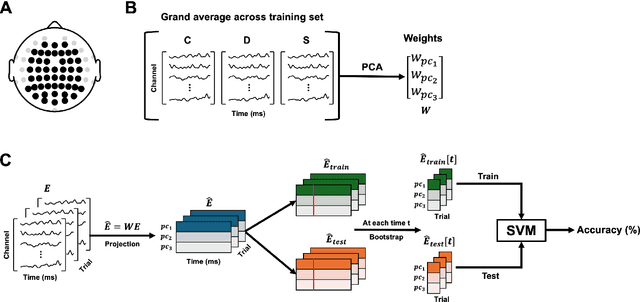
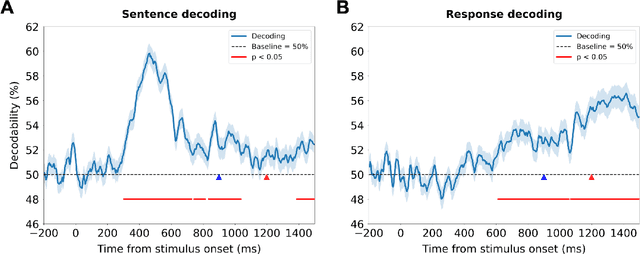
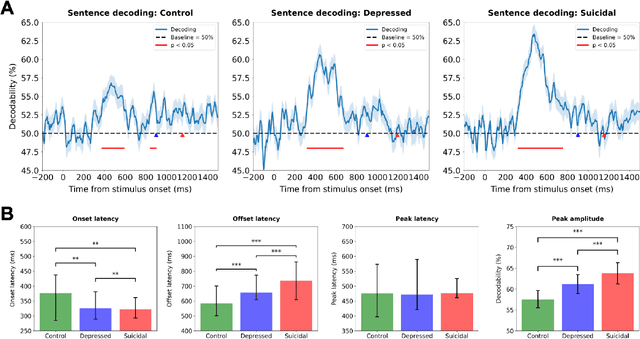
Abstract:Depression and suicidality profoundly impact cognition and emotion, yet objective neurophysiological biomarkers remain elusive. We investigated the spatiotemporal neural dynamics underlying affective semantic processing in individuals with varying levels of clinical severity of depression and suicidality using multivariate decoding of electroencephalography (EEG) data. Participants (N=137) completed a sentence evaluation task involving emotionally charged self-referential statements while EEG was recorded. We identified robust, neural signatures of semantic processing, with peak decoding accuracy between 300-600 ms -- a window associated with automatic semantic evaluation and conflict monitoring. Compared to healthy controls, individuals with depression and suicidality showed earlier onset, longer duration, and greater amplitude decoding responses, along with broader cross-temporal generalization and increased activation of frontocentral and parietotemporal components. These findings suggest altered sensitivity and impaired disengagement from emotionally salient content in the clinical groups, advancing our understanding of the neurocognitive basis of mental health and providing a principled basis for developing reliable EEG-based biomarkers of depression and suicidality.
Neural Responses to Affective Sentences Reveal Signatures of Depression
Jun 06, 2025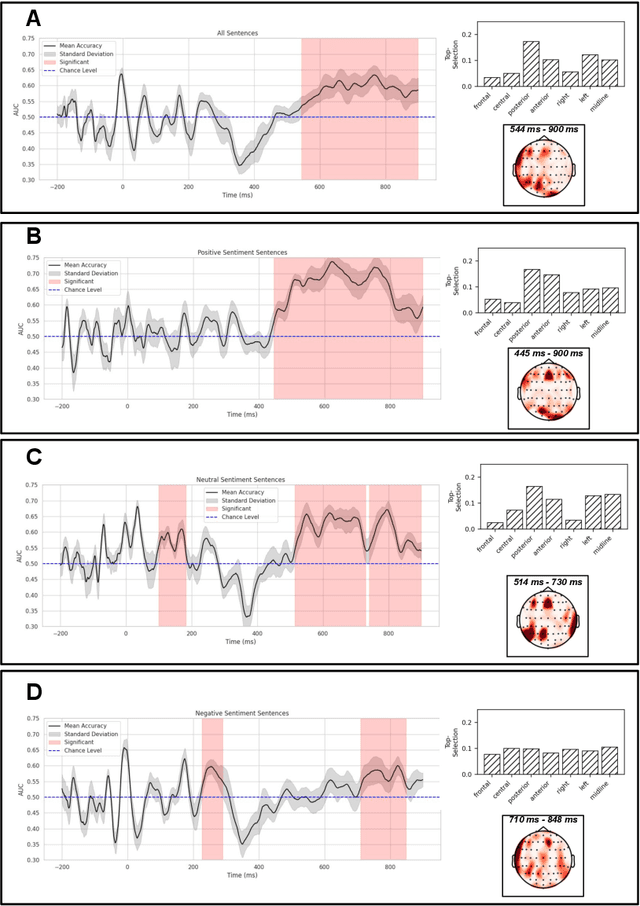
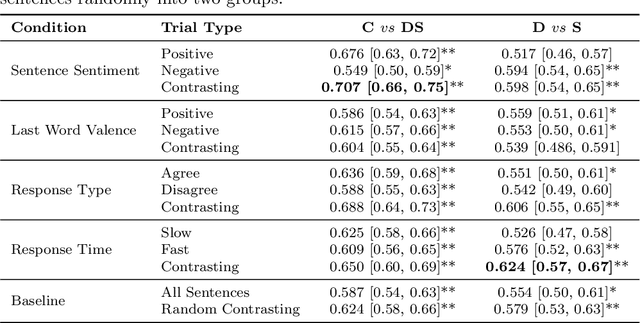
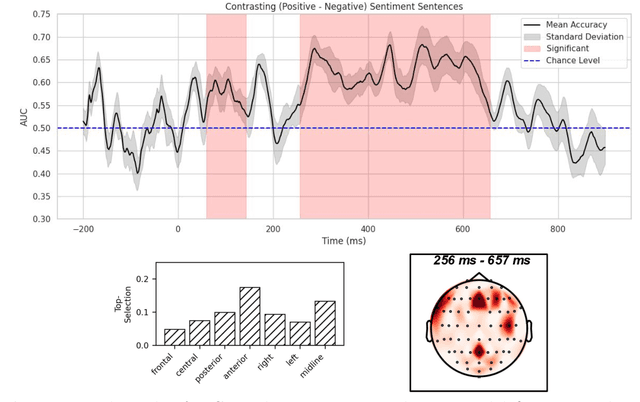

Abstract:Major Depressive Disorder (MDD) is a highly prevalent mental health condition, and a deeper understanding of its neurocognitive foundations is essential for identifying how core functions such as emotional and self-referential processing are affected. We investigate how depression alters the temporal dynamics of emotional processing by measuring neural responses to self-referential affective sentences using surface electroencephalography (EEG) in healthy and depressed individuals. Our results reveal significant group-level differences in neural activity during sentence viewing, suggesting disrupted integration of emotional and self-referential information in depression. Deep learning model trained on these responses achieves an area under the receiver operating curve (AUC) of 0.707 in distinguishing healthy from depressed participants, and 0.624 in differentiating depressed subgroups with and without suicidal ideation. Spatial ablations highlight anterior electrodes associated with semantic and affective processing as key contributors. These findings suggest stable, stimulus-driven neural signatures of depression that may inform future diagnostic tools.
Articulatory Feature Prediction from Surface EMG during Speech Production
May 20, 2025



Abstract:We present a model for predicting articulatory features from surface electromyography (EMG) signals during speech production. The proposed model integrates convolutional layers and a Transformer block, followed by separate predictors for articulatory features. Our approach achieves a high prediction correlation of approximately 0.9 for most articulatory features. Furthermore, we demonstrate that these predicted articulatory features can be decoded into intelligible speech waveforms. To our knowledge, this is the first method to decode speech waveforms from surface EMG via articulatory features, offering a novel approach to EMG-based speech synthesis. Additionally, we analyze the relationship between EMG electrode placement and articulatory feature predictability, providing knowledge-driven insights for optimizing EMG electrode configurations. The source code and decoded speech samples are publicly available.
Deep Learning Characterizes Depression and Suicidal Ideation from Eye Movements
Apr 29, 2025Abstract:Identifying physiological and behavioral markers for mental health conditions is a longstanding challenge in psychiatry. Depression and suicidal ideation, in particular, lack objective biomarkers, with screening and diagnosis primarily relying on self-reports and clinical interviews. Here, we investigate eye tracking as a potential marker modality for screening purposes. Eye movements are directly modulated by neuronal networks and have been associated with attentional and mood-related patterns; however, their predictive value for depression and suicidality remains unclear. We recorded eye-tracking sequences from 126 young adults as they read and responded to affective sentences, and subsequently developed a deep learning framework to predict their clinical status. The proposed model included separate branches for trials of positive and negative sentiment, and used 2D time-series representations to account for both intra-trial and inter-trial variations. We were able to identify depression and suicidal ideation with an area under the receiver operating curve (AUC) of 0.793 (95% CI: 0.765-0.819) against healthy controls, and suicidality specifically with 0.826 AUC (95% CI: 0.797-0.852). The model also exhibited moderate, yet significant, accuracy in differentiating depressed from suicidal participants, with 0.609 AUC (95% CI 0.571-0.646). Discriminative patterns emerge more strongly when assessing the data relative to response generation than relative to the onset time of the final word of the sentences. The most pronounced effects were observed for negative-sentiment sentences, that are congruent to depressed and suicidal participants. Our findings highlight eye tracking as an objective tool for mental health assessment and underscore the modulatory impact of emotional stimuli on cognitive processes affecting oculomotor control.
Early Detection of Coffee Leaf Rust Through Convolutional Neural Networks Trained on Low-Resolution Images
Jul 20, 2024


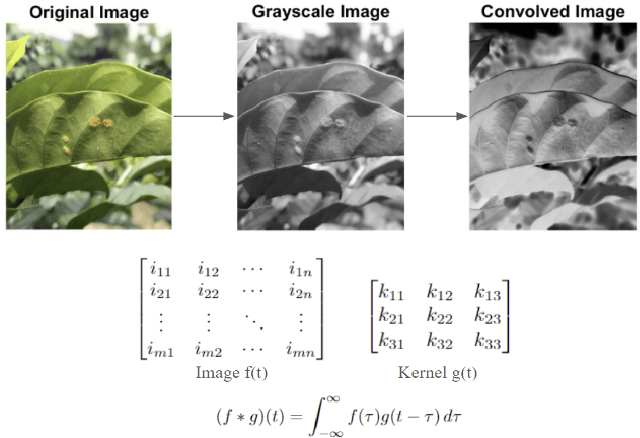
Abstract:Coffee leaf rust, a foliar disease caused by the fungus Hemileia vastatrix, poses a major threat to coffee production, especially in Central America. Climate change further aggravates this issue, as it shortens the latency period between initial infection and the emergence of visible symptoms in diseases like leaf rust. Shortened latency periods can lead to more severe plant epidemics and faster spread of diseases. There is, hence, an urgent need for effective disease management strategies. To address these challenges, we explore the potential of deep learning models for enhancing early disease detection. However, deep learning models require extensive processing power and large amounts of data for model training, resources that are typically scarce. To overcome these barriers, we propose a preprocessing technique that involves convolving training images with a high-pass filter to enhance lesion-leaf contrast, significantly improving model efficacy in resource-limited environments. This method and our model demonstrated a strong performance, achieving over 90% across all evaluation metrics--including precision, recall, F1-score, and the Dice coefficient. Our experiments show that this approach outperforms other methods, including two different image preprocessing techniques and using unaltered, full-color images.
Toward Fully-End-to-End Listened Speech Decoding from EEG Signals
Jun 12, 2024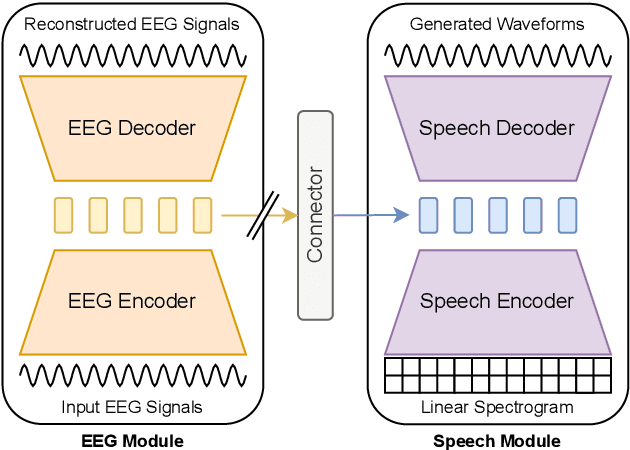



Abstract:Speech decoding from EEG signals is a challenging task, where brain activity is modeled to estimate salient characteristics of acoustic stimuli. We propose FESDE, a novel framework for Fully-End-to-end Speech Decoding from EEG signals. Our approach aims to directly reconstruct listened speech waveforms given EEG signals, where no intermediate acoustic feature processing step is required. The proposed method consists of an EEG module and a speech module along with a connector. The EEG module learns to better represent EEG signals, while the speech module generates speech waveforms from model representations. The connector learns to bridge the distributions of the latent spaces of EEG and speech. The proposed framework is both simple and efficient, by allowing single-step inference, and outperforms prior works on objective metrics. A fine-grained phoneme analysis is conducted to unveil model characteristics of speech decoding. The source code is available here: github.com/lee-jhwn/fesde.
Evaluating Atypical Gaze Patterns through Vision Models: The Case of Cortical Visual Impairment
Feb 15, 2024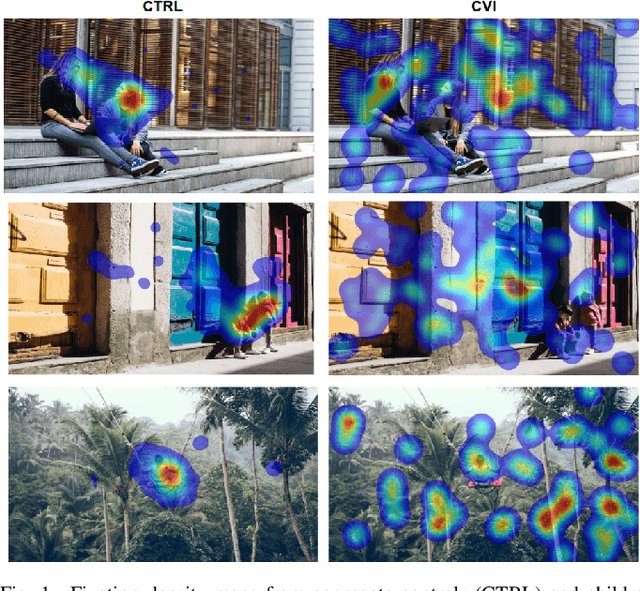


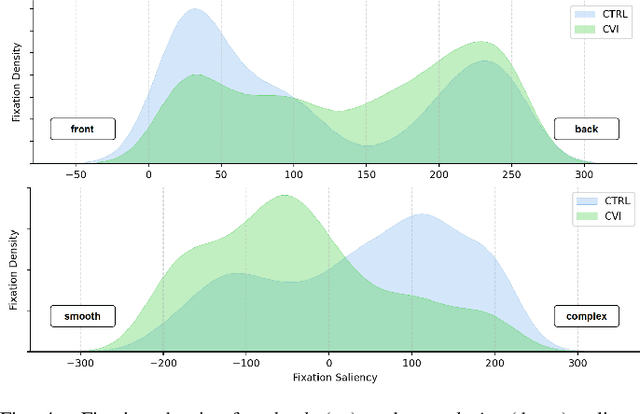
Abstract:A wide range of neurological and cognitive disorders exhibit distinct behavioral markers aside from their clinical manifestations. Cortical Visual Impairment (CVI) is a prime example of such conditions, resulting from damage to visual pathways in the brain, and adversely impacting low- and high-level visual function. The characteristics impacted by CVI are primarily described qualitatively, challenging the establishment of an objective, evidence-based measure of CVI severity. To study those characteristics, we propose to create visual saliency maps by adequately prompting deep vision models with attributes of clinical interest. After extracting saliency maps for a curated set of stimuli, we evaluate fixation traces on those from children with CVI through eye tracking technology. Our experiments reveal significant gaze markers that verify clinical knowledge and yield nuanced discriminability when compared to those of age-matched control subjects. Using deep learning to unveil atypical visual saliency is an important step toward establishing an eye-tracking signature for severe neurodevelopmental disorders, like CVI.
Scaling Representation Learning from Ubiquitous ECG with State-Space Models
Sep 26, 2023Abstract:Ubiquitous sensing from wearable devices in the wild holds promise for enhancing human well-being, from diagnosing clinical conditions and measuring stress to building adaptive health promoting scaffolds. But the large volumes of data therein across heterogeneous contexts pose challenges for conventional supervised learning approaches. Representation Learning from biological signals is an emerging realm catalyzed by the recent advances in computational modeling and the abundance of publicly shared databases. The electrocardiogram (ECG) is the primary researched modality in this context, with applications in health monitoring, stress and affect estimation. Yet, most studies are limited by small-scale controlled data collection and over-parameterized architecture choices. We introduce \textbf{WildECG}, a pre-trained state-space model for representation learning from ECG signals. We train this model in a self-supervised manner with 275,000 10s ECG recordings collected in the wild and evaluate it on a range of downstream tasks. The proposed model is a robust backbone for ECG analysis, providing competitive performance on most of the tasks considered, while demonstrating efficacy in low-resource regimes. The code and pre-trained weights are shared publicly at https://github.com/klean2050/tiles_ecg_model.
Emotion-Aligned Contrastive Learning Between Images and Music
Aug 24, 2023Abstract:Traditional music search engines rely on retrieval methods that match natural language queries with music metadata. There have been increasing efforts to expand retrieval methods to consider the audio characteristics of music itself, using queries of various modalities including text, video, and speech. Most approaches aim to match general music semantics to the input queries, while only a few focus on affective qualities. We address the task of retrieving emotionally-relevant music from image queries by proposing a framework for learning an affective alignment between images and music audio. Our approach focuses on learning an emotion-aligned joint embedding space between images and music. This joint embedding space is learned via emotion-supervised contrastive learning, using an adapted cross-modal version of the SupCon loss. We directly evaluate the joint embeddings with cross-modal retrieval tasks (image-to-music and music-to-image) based on emotion labels. In addition, we investigate the generalizability of the learned music embeddings with automatic music tagging as a downstream task. Our experiments show that our approach successfully aligns images and music, and that the learned embedding space is effective for cross-modal retrieval applications.
 Add to Chrome
Add to Chrome Add to Firefox
Add to Firefox Add to Edge
Add to Edge